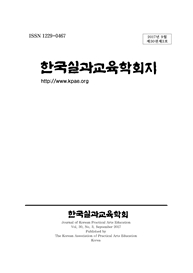학술논문
소프트웨어교육을 위한 컴퓨팅 사고력 기반 실생활 문제해결(CT-RLPS)모형 개발
이용수 330
- 영문명
- Development of Real-Life Problem Solving Model(CT-RLPS Model) based on Computational Thinking for Software Education
- 발행기관
- 한국실과교육학회
- 저자명
- 이철현(Lee, Chul-hyun)
- 간행물 정보
- 『한국실과교육학회지』제30권 제3호, 33~57쪽, 전체 25쪽
- 주제분류
- 사회과학 > 교육학
- 파일형태
- 발행일자
- 2017.09.30
5,800원
구매일시로부터 72시간 이내에 다운로드 가능합니다.
이 학술논문 정보는 (주)교보문고와 각 발행기관 사이에 저작물 이용 계약이 체결된 것으로, 교보문고를 통해 제공되고 있습니다.

국문 초록
이 연구의 목적은 소프트웨어 교육을 위하여 컴퓨팅 사고력 기반의 소프트웨어 수업모형으로써 실생활을 소재로 하는 문제해결 모형을 개발하고, 이 모형을 실생활 문제에 적용해 봄으로써 모형의 적용 가능성을 확인하는데 있다. 컴퓨팅사고의 개념과 하위요소를 탐색하였고, 연구 주제와 관련된 선행 연구를 조사 및 분석하였다. 모형 개발을 위하여 CT-PS(Computational Thinking based Problem Solving)모형을 탐색하였고, 이 모형을 토대로 CT-RLPS(Computational Thinking based Real Life Problem Solving) 모형을 제안하였다. 이 모형의 타당도를 검증하기 위하여 모형의 7가지 측면에 대해 12명의 소프트웨어교육 전문가를 대상으로 타당성 및 의견 조사를 실시하였다. 조사 결과에 대해 CVR분석을 통해 기준값보다 낮은 항목이 발견되었고, 전문가 의견 분석 및 종합을 통해 타당도가 낮은 이유를 발견할 수 있었다. CVR분석 및 전문가 의견을 토대로 모형을 수정 및 보완하여 최종 CT-RLPS모형을 제안하였다. 모형의 실생활 문제적용 가능성을 확인하기 위하여 실생활 문제의 조건을 탐색하였고, ‘체험학습장소 설문조사하기’문제에 모형을 적용하여 문제 해결을 시도한 결과 모형의 적용가능 성을 확인할 수 있었다. CT-RLPS모형의 이용자는 이 사례를 참고하여 다른 실생활 문제에 모형을 적용할 수 있다. 마지막으로 CT-RLPS 모형 이용의 수월성을 높이기 위하여 이 모형을 실생활 문제에 적용할 때 유의해야 할 점을 제시하였다. 결론적으로 CT-RLPS모형은 ‘문제 분석 및 분해’, ‘설계’, ‘구현’의 3단계로 구성되고, 각 단계의 하위 요소를 실생활 문제에 적용함으로써 컴퓨팅사고를 훈련할 수 있을 것으로 기대한다.
영문 초록
The purpose of this research is to develop a real-life problem solving model based on computational thinking and to confirm the applicability of the model by applying this model to real problems. We explored the concept and sub-elements of computational thinking, investigated and analyzed prior research related to research themes. In order to develop a model, we searched for CT-PS(Computational Thinking based Problem Solving) model and proposed CT-RLPS(Computational Thinking based Real-Life Problem Solving) model based on this model.
In order to verify the validity of this model, we conducted a validity and opinion survey for 12 software education experts on seven aspects of the model. As for the results of the survey, items lower than the reference value were discovered through CVR analysis, and it was possible to discover reasons of the low validity through the analysis and synthesis of expert opinions. We modified and complemented the model based on CVR analysis and opinion of experts, and proposed the final CT-RLPS model. We explored the conditions of the real-life problems in order to confirm the applicability of the model to the real-life problem. And we applied this model to the problem Surveying the place for active learning in school and tried solving the problem, and as a result we could confirm the applicability of the model. A user of the CTR-PS model can apply the model to the other real-life problems with reference to this case. Finally, we presented points to be noted when applying this model to real-life problems in order to improve the excellence of using the CT-RLPS model, In conclusion, the CT-RLPS model consists of three stages of Analysis and Decomposition of Problems , Design , Implementation , and we expect students to train the computational thinking by applying sub-elements of each stage to real-life issues.
목차
Ⅰ. 서 론
Ⅱ. 이론적 배경
Ⅲ. 컴퓨팅사고 기반 실생활 문제해결모형(CT-RLPS Model) 개발
Ⅳ. CT-RLPS 모형의 실생활 문제 적용
Ⅴ. 결론 및 제언
키워드
해당간행물 수록 논문
참고문헌
교보eBook 첫 방문을 환영 합니다!

신규가입 혜택 지급이 완료 되었습니다.
바로 사용 가능한 교보e캐시 1,000원 (유효기간 7일)
지금 바로 교보eBook의 다양한 콘텐츠를 이용해 보세요!





